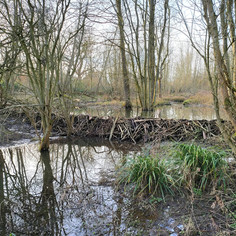Beavers & Natural Flood Management
- Jess Duckenfield

- Apr 7, 2023
- 3 min read
Essex and Suffolk Rivers Trust recently sat down with Archie Ruggles-Brise to find out more about the expanding Beavers & Natural Flood Management project at Spains Hall Estate.

Archie Ruggles-Brise is the Estate Manager of the 2000-acre Spains Hall Estate in North Essex. He is a leader in farming innovation and in 2019 he broke new ground by reintroducing a pair of Eurasian Beavers into an enclosure as part of a nature-led natural flood management project. As the first beavers back in East Anglia since the Middle Ages, the project is now visited by over 500 people annually. The project has been so successful for water management, Archie is embarking on Phase two by extending the project to bring further benefits for flood risk, drought resilience and engagement of the public with these intriguing creatures.
Archie is a Trustee at Essex and Suffolk Rivers Trust and recently spoke to their Director, Helen Dangerfield for a beaver Q&A:
What sort of preparation have you needed to undertake for phase 2?
We have spent 2-3 years planning this project, alongside other wide-ranging estate land use change initiatives. The beaver enclosures require consent from Natural England to allow us to release beavers into them. The fence line (where it crosses the ordinary watercourse) requires land drainage consent from Essex County Council. We were assisted with both by Essex County Council who provided funding for the ecological work to prepare the beaver licence and offered technical support to enable us to submit a successful Section 23 consent.
We then worked with a contractor to build the fence itself, which took about 2 months (it’s 5 km of fencing and 9 river crossings of various sizes). The capital work was supported by a range of organisations, the Environment Agency, Regional Flood and Coastal Committee, Anglian Water, Essex County Council and Essex and Suffolk Water. We are extremely grateful to them as without their support this wouldn’t have been possible.
What will the population carrying capacity be including the new enclosure?
We aren’t sure but as the area is 10x the size of our current enclosure and that is happily accommodating 7 or so individuals in a family group we expect the new beavers will have plenty of space. There will only be one family group in each of our two new 50 acre enclosures (100 acres in total) to start with.
Plenty of room to grow! Two of the four adult beavers (left and middle) released into the new enclosures and a young beaver kit (right) born at Spains Hall. Photos by Simon Hurwitz and Russell Savory.
What are you hoping the main benefit will be from extending your work?
The new beaver enclosures will cover 2km of watercourse, and once the beavers get to work the over deepened and over widened river line will start to become more variable. The flood plain will become permanently flooded in some areas and more connected during high flows along it’s entire length. This will slow flood flows, reduce flood peaks, filter soil and pollutants out of the water and store water throughout the year. This means that in time the river will develop into a wetland area, present all year round, which will be a massive ecological resource as otherwise the estate is dry over summer. So in addition to the flood and rough benefits we will also us ethe beaver enclosure areas to deliver biodiversity gain and carbon sequestration.
Have you learned anything surprising about beavers during the project?
Just the speed at which they can work, and the magnitude of the change they can drive if given the space. They are truly extraordinary engineers! Oh, and they garden, expanding wet areas gives their favourite plants more space to grow, which they encourage by moving root balls and bulbs around, then they get to harvest the results.
Builders, woodworkers and gardeners! Beavers are incredible ecosystem engineers! Photos by Simon Hurwitz and Colin Shead.
Do you have a favourite beaver fact?!
Where do I start? They can hold their breath for up to 15 minutes, which is pretty impressive!
Are there any other species reintroductions (plant, mammal, invertebrates, birds etc) that you would consider for Spains Hall?
As part of the wider ecological masterplan we are keen to try to encourage both dormice and water vole to return, but both might need a bit of assistance once we have created the right habitat conditions for them.
New neighbours? The beavers at Spains Hall could one day be joined by other species such as watervole (left) or dormice (right), if conditions are right to reintroduce them on the estate. Photos from Phil Scarlett and Szymon Bartosz / Getty Images.
Find out more about Beavers & Natural Flood Management























Comments